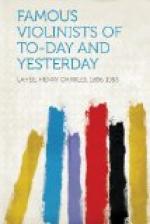He now returned to Bergen, where the air of his native land soon restored him to health. On his arrival, however, he found that the report had been circulated that he had been speculating at the expense of his countrymen, and that they were the only sufferers by his misfortunes.
For a short time he assumed control of the National Theatre, but before long he was again on the road, giving concerts in various parts of Europe. While he was in Paris, in 1862, his wife died.
The year 1867 found him again in the United States, and during this tour he met at Madison, Wis., Miss Sara C. Thorpe, the lady who was to become his second wife. He also took part in the Peace Jubilee in Boston, in 1869.
When he sailed for Norway, in April, 1870 (he was to be married on his arrival), the New York Philharmonic Society presented him with a beautiful silken flag. This flag—the Norwegian colours with the star-spangled banner inserted in the upper staff section—was always carried in the seventeenth of May processions in Bergen, and floated on the fourth of July.
The remaining years of Ole Bull’s life were spent in comparative freedom from strife and struggle. He spent much of his time in Norway, but also found time for many concert tours. His sixty-sixth birthday was spent in Egypt, and he solemnised the occasion by ascending the Pyramid of Cheops and playing, on its pinnacle, his “Saeter-besoeg.” This performance took place at the suggestion of the King of Sweden, to whom the account was duly telegraphed the next morning from Cairo.
In Boston Ole Bull was always a great favourite and had many friends. He felt much interest in the Norsemen’s discovery of America, and took steps to bring the subject before the people of Boston. The result of his efforts is to be seen in the statue of Lief Ericsson, commemorative of the event, which adorns the Public Gardens.
In March and April, 1880, Ole Bull appeared at a few concerts in the Eastern cities, with Miss Thursby, and in June he sailed, for the last time, from America. He was in poor health, but, contrary to all hopes, the sea voyage did not improve his condition, and much anxiety was felt until his home was reached. A few weeks later he died, and, at the funeral, honours more than royal were shown. In the city of Bergen all business was suspended, and the whole population of the city stood waiting to pay their last respects to the celebrated musician and patriot.
Ole Bull was a man of remarkable character and an artist of undoubted genius. All who heard him, or came in contact with him, agree that he was far from being an ordinary man. Tall, of athletic build, with large blue eyes and rich flaxen hair, he was the very type of the Norseman, and there was something in his personal appearance and conversation which acted with almost magnetic power on those who approached him. He was a prince of story-tellers, and his fascination in this respect was irresistible to young and old alike, and its effect not unlike his violin playing.




